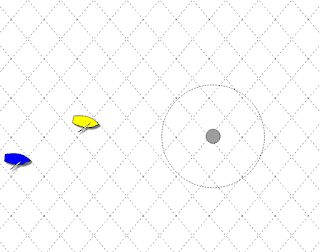Sailing dinghies capsize due to the wind, once capsized they are generally too involved in recovering the boat to worry about the wind but it can have a significant effect on how easy it is to recover the boat. One can excuse powerboat drivers for ignoring it , but again if they used it life could be so much easier, and the boat would be back in use much quicker.
The most obvious use of wind comes when a boat has inverted and the the centreboard has gone up into the case. The boat will generally lie across the wind. If you get the crew to stand on the leeward gunwale, the boat will begin to right. They can put their fingers into the slot to balance, but the object is to keep their weight on their feet, on the gunwale. The wind will assist this process and as the boat drifts downwind you will generally find that the end of the boom surfaces. THIS IS A GIANT LEVER!. If you, in the powerboat, can get hold of this you can lever the boat upright by working your way along the leach to the masthead.
Once there it is essential that you control the righting, the boat will be downwind, so if you just throw it upright it is quite likely to just go straight over again. Either try and have the crew in a position to be scooped in as per an RYA Capsize recovery, OR walk it upright, keeping hold of the shroud as you work your way towards the boat.
The rig lying upwind is a problem even if the crew are recovering the boat. The most useful thing a powerboat can do in this situation is to get the boat head to wind. To do this put your bow into the bow of the capsized boat, have your crew grab the forestay and reverse upwind, so that the boat comes head to wind. The crew can right it and it might stay upright instead of flipping straight over as it would if you left it. Having your crew in the bow will assist in keeping your transom high and reduce the water taken on board your powerboat.

If the rig is stuck in the mud you have to get it out. Generally the wind will be pushing it deeper and deeper into the mud, otherwise the crew would have recovered it. There are two approaches, you can try and rotate the boat so that the hull is no longer upwind, but you risk bending or breaking the mast. The other method is to pull the boat upwind and have the mast come out of the mud on the same trajectory as it went in. You might put your painter around the shroud and reverse upwind but often you don't get a result, due the inability to develop sufficient power in reverse. You can try getting the line astern, but then you have to be further away from the boat or your prop might be too close to the crew in the water and maintaining the correct angle becomes more difficult.
Another method is to put your bow into the cockpit of the boat and push it out by going ahead. This gives you much more power but you need to be aware that your propeller is close to the mast and mainsail of the boat. The main is usually lying straight down due to the weight of he boom but you need to be careful. Once the mast is out of the mud it will begin to come up alongside your powerboat. Grab the mast, go into neutral, and lift it up, working your way to the masthead. Check the wind, before you start to right it by working back towards the boat lifting the mast over your head. You should have blown round but attempting to push a rig up against the wind is not good news, it's hard. Better to bring the rig round so that it is at least across the wind, being at the masthead should mean that your propeller is well away from the crew.
Finally don't forget that you do NOT want to chop up the sailors with your propeller. If they get close to the prop the quickest and safest way is to pull the kill cord. You will, of course, have checked that it works at the beginning of the day. Be aware that this applies if you are alongside a capsized boat, feet can easily trail under the boat towards your propeller, so know where the crew are!






